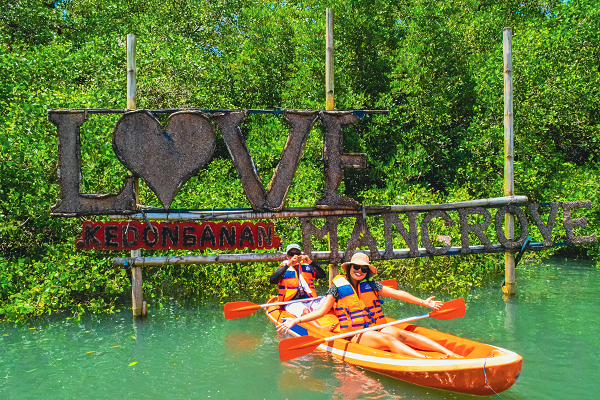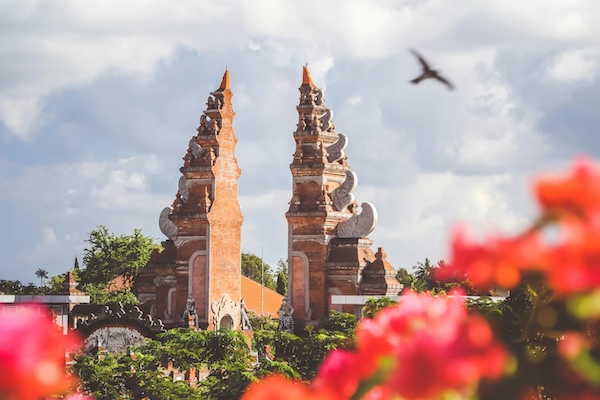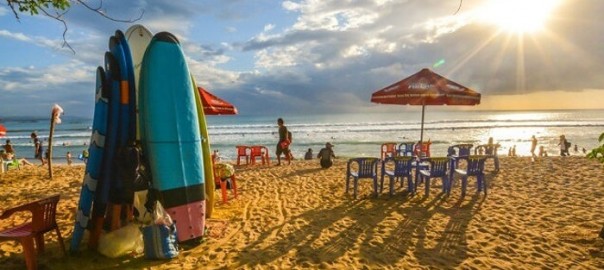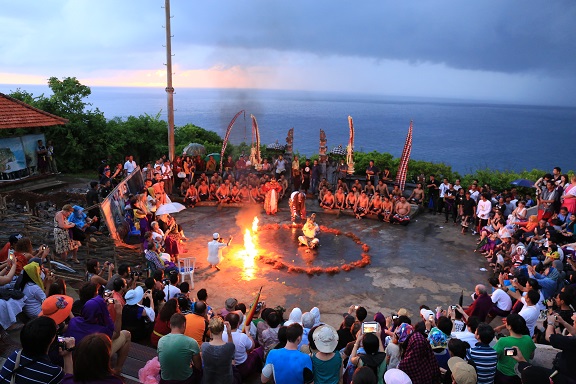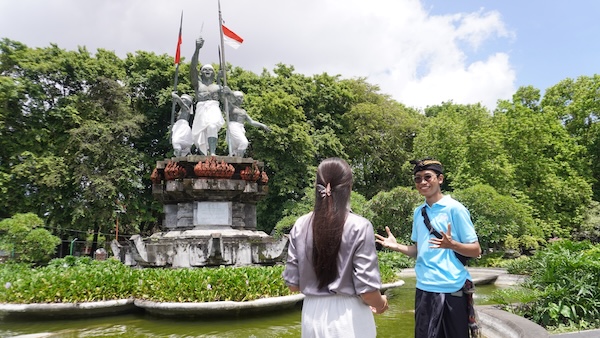Exploring the Wonders of Mangroves in Bali: Understanding the Diversity of Species
Mangroves, the coastal forests that thrive in the borderlands between land and sea, harbor profound ecological wonders. More than just a row of trees along the shore, mangroves act as natural guardians, shielding coastlines from tidal surges, erosion, and sea storms. The uniqueness of this ecosystem lies in its ability to withstand saline water, with its leaves acting as natural filters that maintain salt balance.
Read also: Another side of Bali: Canoe in Mangroves
Bali, an island renowned for its natural beauty, also boasts abundant mangrove forests. Their role here extends beyond ecological benefits, providing economic contributions to the local communities. Despite having various species, it’s fascinating that each mangrove in Bali forms a landscape rich with its own uniqueness. Let’s delve deeper into the wonders of Bali’s mangroves, gaining a more profound understanding of their benefits for the environment and the surrounding life.
Red Mangrove (Rhizophora spp.):Beauty in Color and Ecological Function

The Red Mangrove (Rhizophora spp.) emerges as a captivating and ecologically significant species, thriving in coastal areas, especially within tidal mudflats and brackish water environments. Here are some key aspects of the Red Mangrove:
→What are the characteristics of Red Mangrove?
Prop Roots: One of the most striking features of the Red Mangrove is its extensive system of prop roots. These roots extend from the trunk and branches, creating a dense network that provides stability in the muddy substrate and allows the tree to withstand tidal fluctuations.
Viviparous Seeds: Red Mangroves reproduce through viviparous seeds. The seeds germinate while still attached to the parent tree, forming seedlings with a developed root system before falling into the water. This adaptation increases the chances of successful seedling establishment.
Salt Exclusion Mechanism: Red Mangroves have specialized cells on their leaves that actively exclude salt, allowing them to thrive in saline environments. The leaves also feature a waxy coating to minimize water loss through evaporation.
→ How about the Ecological Roles?
Coastal Protection: The extensive prop root system of Red Mangroves helps stabilize the coastline, preventing erosion and acting as a natural barrier against storm surges and strong waves.
Habitat for Marine Life: The complex root structure provides an ideal habitat for various marine organisms. The underwater roots serve as nurseries for fish and shelter for crustaceans, contributing to the overall biodiversity of coastal ecosystems.
Carbon Sequestration: Red Mangroves play a crucial role in carbon sequestration. They trap and store significant amounts of carbon in both aboveground biomass and the sediment, helping mitigate the effects of climate change.
Water Filtration: The root system of Red Mangroves acts as a natural water filtration system. It traps sediments and pollutants, preventing them from entering the open water and maintaining water quality in coastal areas.
→Here Their Adaptations to Tidal Environments:
Aerobic Roots: Red Mangroves have specialized aerial roots that can absorb oxygen from the air, allowing them to survive in waterlogged soils with low oxygen levels.
Tolerance to Salinity: The ability to exclude salt and thrive in saline conditions makes Red Mangroves well-adapted to coastal environments where freshwater and seawater mix.
Halophytic Nature: Red Mangroves are halophytes, plants adapted to grow in saline conditions. Their unique physiological adaptations enable them to thrive in environments where other terrestrial plants would struggle.
Red Mangroves, with their remarkable adaptations and ecological functions, exemplify the resilience of plant life in challenging coastal ecosystems. They contribute significantly to the health and sustainability of mangrove ecosystems and play a vital role in supporting coastal biodiversity.
Avicennia Mangrove (Avicennia spp.):Thriving in Challenging Conditions

Avicennia Mangrove (Avicennia spp.) is a unique and ecologically important mangrove species with distinct characteristics and ecological roles. Let’s delve into the key aspects of Avicennia Mangrove:
→About Distinctive Features:
Pneumatophores: Avicennia Mangroves are characterized by pneumatophores, specialized vertical roots that emerge from the soil and protrude above the ground. These structures facilitate gas exchange, allowing the mangrove to obtain oxygen even in waterlogged or muddy conditions.
Salt Exclusion Mechanism: Similar to other mangrove species, Avicennia has adaptations to exclude salt. It possesses salt glands on its leaves that actively excrete excess salt, enabling the mangrove to thrive in saline environments.
Longitudinal Veins: The leaves of Avicennia Mangroves have distinct longitudinal veins, providing structural support to the leaves and contributing to their ability to withstand strong winds and turbulent conditions.
→Here The Ecological Roles:
Erosion Prevention: The complex root system of Avicennia Mangroves, including pneumatophores, helps stabilize the soil and prevent erosion. This is particularly crucial in coastal areas where the land is vulnerable to tidal forces.
Habitat for Fauna: The intricate root system and the shelter provided by Avicennia Mangroves create a conducive habitat for various marine and bird species. The submerged roots offer refuge for fish and crustaceans, enhancing biodiversity.
Water Filtration: The root system acts as a natural filter, trapping sediments and pollutants. This contributes to maintaining water quality in the surrounding areas and provides a buffer against the negative impacts of runoff from land.
→Adaptations to Tidal Environments:
Viviparous Seeds: Avicennia Mangroves reproduce through viviparous seeds, similar to Red Mangroves. The seeds germinate on the tree, forming seedlings with a developed root system before dropping into the water.
Tolerance to Salinity: The ability to tolerate high salinity levels allows Avicennia Mangroves to thrive in areas where freshwater and seawater mix, creating brackish conditions.
Aerobic Roots: The pneumatophores of Avicennia Mangroves play a crucial role in facilitating oxygen intake in waterlogged soils. This adaptation allows the mangrove to survive in anaerobic conditions.
Avicennia Mangroves, with their unique features and ecological functions, contribute significantly to the resilience of mangrove ecosystems. Their ability to adapt to challenging tidal environments makes them essential components in coastal areas, playing a vital role in supporting biodiversity and mitigating environmental impacts.
Mangrove Bakau (Bruguiera spp.) : Foundation of Ecosystem Stability

Bruguiera spp or more commonly known as the Mangrove Bakau, is an intriguing group of mangroves with several special adaptations that enable them to thrive in harsh and ever-changing tidal environments. It is one of the mangrove species found in various tropical and subtropical regions worldwide, including the waters around Bali.
→ Some Distinctive Features:
Root Structure: Mangrove Bakau is renowned for its unique aerial roots that curve downward from its branches. These roots, often referred to as “stilt roots” or “prop roots,” provide additional support and help stabilize the tree in the loose tidal mud.
Adaptive Leaves: The leaves of Mangrove Bakau have special adaptations to cope with high salinity and challenging environments. Some Bruguiera species have crescent or elliptical-shaped leaves with pointed tips. This adaptation helps reduce water evaporation and minimize water loss in hot and salty environmental conditions.
Tolerance to Extreme Environments: Mangrove Bakau exhibits high resilience to harsh environmental conditions, such as sea-level rise and changes in salinity. They can thrive in mud with high salt content and can grow in areas frequently inundated by seawater.
Reproduction through Air Humidity: An unique method of reproduction is through air humidity. Mangrove Bakau can produce seeds that germinate before falling from the tree. These seeds can then sprout upon reaching suitable substrate, such as wet mud.
Sonneratia Mangrove (Sonneratia spp.):Unique and Salt-Tolerant

Sonneratia Mangrove (Sonneratia spp.) is a mangrove species with distinctive characteristics and ecological roles. Let’s explore some key aspects of Sonneratia mangrove:
→Distinctive Features? Here is it:
Breathing Roots: Sonneratia mangrove has breathing roots that allow gas exchange in the aquatic environment. These roots grow from the base of the stem and protrude above the water surface during high tide.
Elephant Ear-Shaped Fruit: The fruit of Sonneratia mangrove has a unique elephant ear-like shape. The fruit contains seeds that can germinate while still on the tree or after falling into the water.
Wide Ecological Functions: Besides providing a habitat for various marine organisms, Sonneratia also plays a role in coastal protection from erosion and storms with its strong root system.
→What Their Ecological Roles?
Water Filtration: The roots and breathing roots of Sonneratia serve as a natural filter, cleansing water from sediment and pollutants before reaching the open sea.
Nursery Ground for Fish and Shrimp: The plants and roots of Sonneratia mangrove create an ideal habitat for juvenile fish and shrimp, offering shelter and a food source.
Contribution to Coastal Safety: With robust growth and spreading roots, Sonneratia helps stabilize the soil in coastal areas, reducing coastal erosion and mitigating storm impacts.
→Adaptations to the Environment:
Salinity Tolerance: Like other mangrove species, Sonneratia can tolerate high salinity levels, allowing it to thrive in brackish water and contribute to the mangrove ecosystem.
Reproduction through Floating Seeds: Sonneratia’s fruit contains floating seeds, facilitating effective seed dispersal through water and supporting mangrove regeneration in new locations.
Tolerance to Tidal Changes: The ability to grow in tidal areas enables Sonneratia to withstand environments with periodic changes in water levels.
Sonneratia Mangrove, with its distinctive features and contributions to the coastal ecosystem, provides insight into its adaptations and crucial role in supporting biodiversity and environmental sustainability in coastal regions.
Ceriops Mangrove (Ceriops spp.): Small Yet Valuable

Ceriops Mangrove (Ceriops spp.) is a fascinating mangrove species with distinctive features and ecological significance. Let’s delve into some key aspects of Ceriops mangrove:
→Look at Distinctive Features:
Knee Roots: Ceriops is known for its knee roots, which are upward extensions from underground roots. These knee roots protrude above the ground, providing stability to the tree and aiding in aeration.
Greyish Appearance: The leaves and bark of Ceriops mangrove often have a greyish tint, giving the tree a unique and recognizable appearance in the mangrove ecosystem.
Conical Flower Clusters: Ceriops produces conical flower clusters that add to its visual appeal. These flowers play a crucial role in the reproductive process of the mangrove.
→Their Ecological Roles? Here is it:
Habitat for Fauna: The intricate root system of Ceriops provides a habitat for various marine and terrestrial organisms. The knee roots, in particular, serve as perches for birds and shelter for small marine life.
Sediment Stabilization: Ceriops mangrove plays a vital role in stabilizing sediments along coastal areas. The extensive root system helps prevent erosion and contributes to the overall resilience of the shoreline.
Salt Exclusion Mechanism: The greyish coloration of Ceriops leaves is associated with its salt exclusion mechanism. This adaptation allows the mangrove to limit salt intake, enhancing its ability to thrive in brackish water.
→Adjustment to the Environment:
Tolerance to Salinity Fluctuations: Ceriops exhibits tolerance to fluctuations in salinity levels, making it well-suited for environments where water salinity can vary.
Aerial Propagation: The knee roots of Ceriops aid in aerial propagation. These roots can produce new shoots when they come in contact with the ground, contributing to the mangrove’s ability to spread and colonize.
Reproductive Strategy: Ceriops employs a reproductive strategy involving its conical flower clusters. The flowers mature into fruits, containing seeds that can be dispersed by water, promoting the regeneration of Ceriops in different areas.
Ceriops Mangrove, with its unique features and ecological contributions, stands as an integral component of mangrove ecosystems. Its adaptations highlight its ability to thrive in challenging coastal environments while providing essential ecological services.
Xylocarpus Mangrove (Xylocarpus spp.):Elegance in Tidal Areas

Xylocarpus Mangrove (Xylocarpus spp.) is a distinctive mangrove species known for its unique features and ecological importance. Let’s explore key aspects of Xylocarpus mangrove:
→Distinctive Features:
Cork-Like Bark: Xylocarpus is recognized for its cork-like bark, which sets it apart in the mangrove landscape. This bark provides protection to the tree in challenging coastal environments.
Pneumatophores: The mangrove develops pneumatophores, specialized vertical root structures that emerge above the ground. These structures facilitate the exchange of gases, allowing the mangrove to access oxygen in waterlogged soils.
Fruit with Woody Pods: Xylocarpus produces distinctive woody fruits known as “xylocarps” or “cannonball fruits.” These round, heavy fruits have a hard shell and contain seeds, playing a role in the mangrove’s reproductive strategy.
→Ecological Roles:
Habitat for Fauna: The intricate root system, including pneumatophores, provides a habitat for various marine organisms. The submerged roots offer shelter for fish and crustaceans, contributing to biodiversity.
Erosion Control: Xylocarpus mangrove plays a crucial role in controlling erosion along coastlines. The extensive root system helps stabilize soil, preventing the loss of land to tidal action and wave impact.
Tannins and Medicinal Uses: The bark and leaves of Xylocarpus contain tannins, and in some cultures, these have been used for medicinal purposes. Tannins have antimicrobial properties and may be utilized in traditional medicine.
→Adaptations to the Environment:
Salt Exclusion Mechanism: Xylocarpus, like many mangroves, has mechanisms to exclude salt. This allows the mangrove to thrive in brackish water conditions, where salinity levels can fluctuate.
Tolerance to Waterlogged Soils: The development of pneumatophores is an adaptation to waterlogged soils. These structures allow the mangrove to respire in anaerobic conditions by obtaining oxygen from the air.
Reproductive Strategy: The “cannonball fruits” of Xylocarpus are a key element of its reproductive strategy. The heavy fruits fall into the water, aiding in seed dispersal and promoting the establishment of new mangrove plants.
Xylocarpus Mangrove, with its unique characteristics and ecological contributions, plays a vital role in the complex and dynamic mangrove ecosystems. Its adaptations allow it to thrive in challenging coastal environments while providing valuable ecological services.
Moreover, apart from its pivotal role in the mangrove ecosystem, different components of the Xylocarpus granatum tree hold economic significance. The oil derived from the plant’s seeds, identified as tengkawang oil, finds application in various industrial products, including soap and cosmetic items.
How to navigate through the mangrove forest?
This point is an additional brief overview of how to navigate through the mangrove forest. In Bali’s mangrove forest, visitors can enjoy a unique exploration with various modes of transportation. Several common ways to navigate the mangrove forest include traditional boats, canoes, and wooden bridges crossing the mangrove river streams. Each mode of transportation offers a different experience, allowing you to get close to mangrove life and appreciate the beauty of nature in diverse ways.
Traditional boats, for example, provide a serene rowing experience while enjoying the surrounding scenery; meanwhile, canoes offer flexibility to explore hidden corners of the mangrove forest. Additionally, wooden bridges provide a stable path for walking, allowing visitors to soak in the beauty of the mangrove ecosystem from a higher vantage point.
With these options at hand, visitors can choose an adventure that suits their preferences and comfort. The diversity of transportation not only enhances the exploration but also adds another dimension to the adventure, enabling a deeper experience in exploring the richness of Bali’s mangrove forest.
Proud Diversity
In its various forms along Bali’s coastline, mangroves serve not only as natural protectors and salt filters but also have a positive impact in supporting marine life. The towering roots of mangroves provide shelter for various fish, shrimp, and mollusks, creating a biodiverse ecosystem.
Furthermore, mangroves play a vital role in natural disaster mitigation. With their strong roots, they can reduce the risk of coastal erosion caused by tidal waves and storms. The presence of mangroves also helps mitigate the impacts of climate change by absorbing carbon dioxide from the atmosphere.
As stewards of nature, it is crucial for us to continue understanding, appreciating, and engaging communities in mangrove conservation efforts. Only through sustainable cooperation can we ensure that Bali’s natural wealth, especially its mangroves, remains a valuable heritage for the future.


